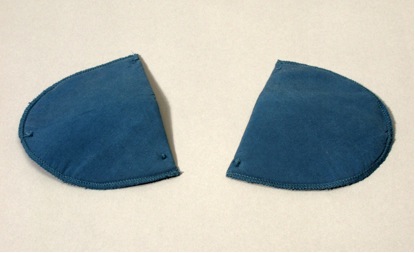Shoulder pads
Oxford, UK
 Donated by Julia Cousins in 2002; 2002.28.1Films, music, magazines and television have had a huge impact on fashion trends, using celebrities as models for both clothing styles and body shapes. Individual stars often became associated with certain styles. This was the case with the shoulder-pad, a type of padding permanently stitched or temporarily affixed inside jackets, blazers and tops to create a broader, straighter shoulder line. The star in question was the actress Joan Crawford in the 1930s.
Donated by Julia Cousins in 2002; 2002.28.1Films, music, magazines and television have had a huge impact on fashion trends, using celebrities as models for both clothing styles and body shapes. Individual stars often became associated with certain styles. This was the case with the shoulder-pad, a type of padding permanently stitched or temporarily affixed inside jackets, blazers and tops to create a broader, straighter shoulder line. The star in question was the actress Joan Crawford in the 1930s.
Fashion designer Elsa Schiaparelli was noted for a number of innovations such as the invention of modern culottes, the 'wedge' heeled shoe, coloured zips, and her concept of a fashion show incorporating a 'catwalk' for models. It was Schiaparelli who pioneered the use of shoulder pads in her 1931 collection, but it was not until Crawford wore them in an iconic dress in the film Letty Lynch the following year that they became widely adopted. Following the release of the film, the department store Macy's in New York is reputed to have sold over 500,000 copies of the dress and shoulder pads became Crawford's signature look.
Originally stuffed with wool, cotton or sawdust, shoulder pads featured strongly in the fashions of the early 1940s during the Second World War when women's clothing became increasingly militarized and masculine with boxy, functional forms. After disappearing from the fashion scene for several decades shoulder pads made a comeback in the 1980s, and were made from synthetic materials such as the ones shown here. They represented female power and independence at a time when women were increasingly entering careers in traditionally male-dominated sectors such as business and politics. American film and television continued to promote the shoulder pad in that decade with the internationally transmitted soaps Dynasty and Dallas, in which the wealthy and assertive female characters wore exaggerated shoulder pads.
